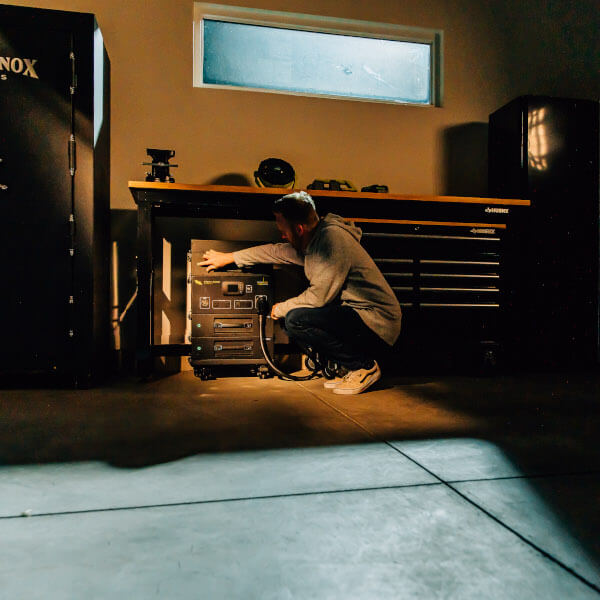Power outages are more than just an inconvenience—they can be dangerous and even life-threatening. In recent years, the U.S. has experienced an alarming increase in power disruptions. According to the U.S. Energy Information Administration (EIA), the average duration of power outages per customer has nearly doubled over the past decade. Severe weather events, aging infrastructure, and increased energy demand have all contributed to these prolonged blackouts. In fact, Texas, California, and Florida are among the top states with the highest number of power outages.
Are you prepared to handle an extended outage? Whether you’re a seasoned prepper or just beginning your home preparedness journey, these 10 power outage survival tips will help keep you safe, comfortable, and prepared for the unexpected.
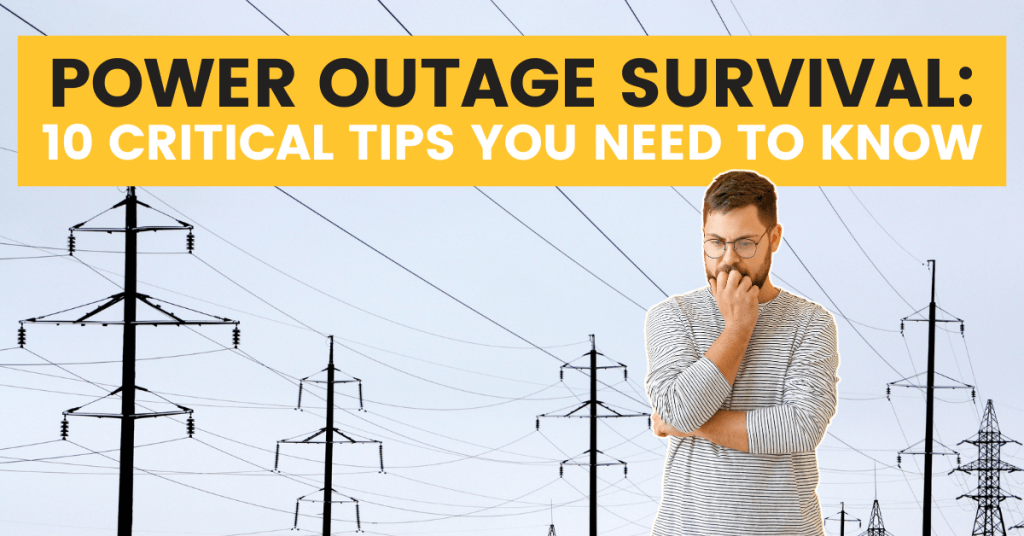
A prolonged power outage means your usual grocery runs may not be possible. That’s why emergency preparedness includes having a well-stocked pantry of non-perishable foods. Think about the size of your family, including pets, and set aside at least three days’ worth of food per person in a designated emergency storage bin. However, we recommend stocking up for at least a week, as many outages last longer than anticipated.
Additionally, make sure to use your fridge and freezer wisely – A refrigerator without power will keep food cold for about four hours, while a full freezer will stay cold for up to 48 hours if left closed. A deep freezer provides even longer protection, especially if kept shut tightly. To maximize cold retention, consider freezing jugs of water in advance, which can help maintain low temperatures longer.
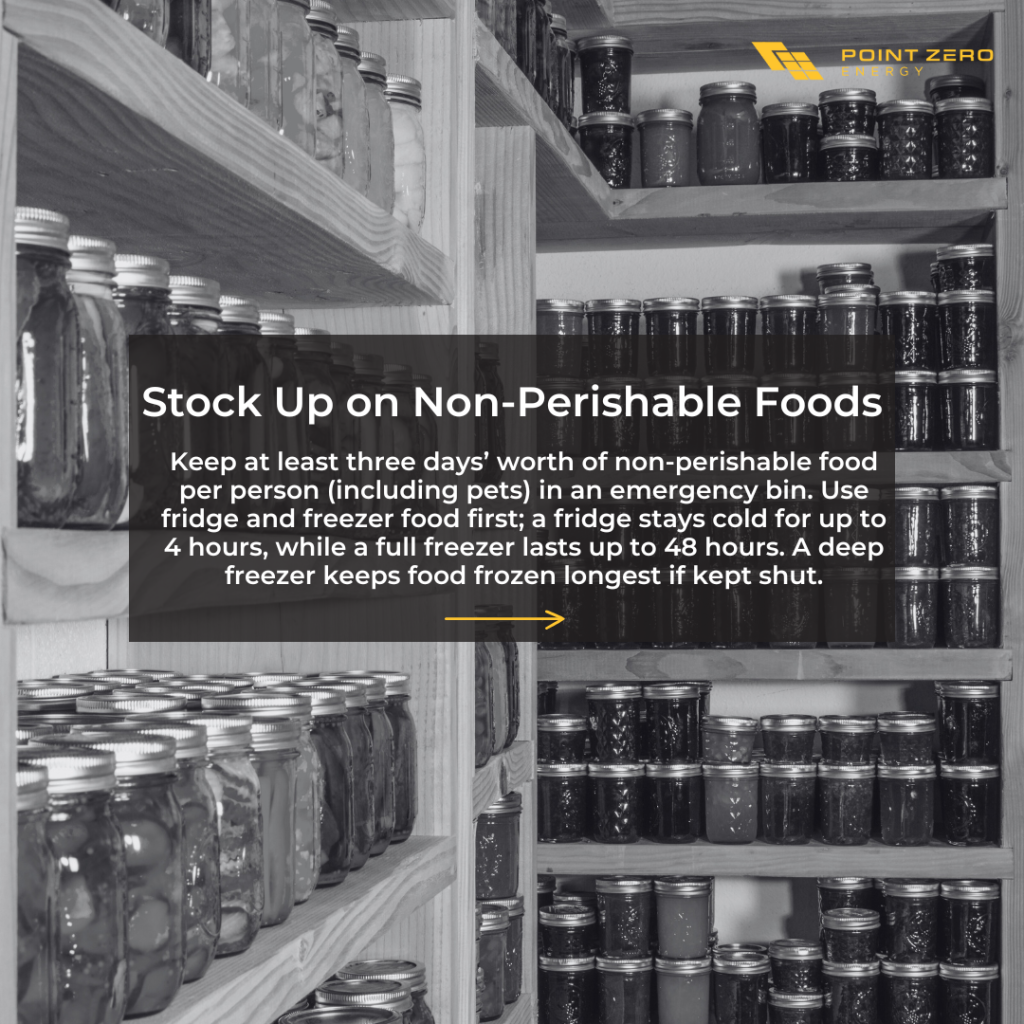
When the grid goes down, having a backup power solution is critical. A home generator—whether gas or solar—can keep essential appliances and medical devices running. Solar generators are an excellent choice for long-term emergency preparedness, as they don’t rely on fuel and can provide sustainable power during extended outages. On the other hand, gas generators can power your home quickly but require proper ventilation and fuel storage.
| Feature | Solar Generators | Gas Generators |
|---|---|---|
| Fuel Source | Renewable (sunlight) | Gasoline, propane, or diesel |
| Runtime | Unlimited with sunlight | Limited by fuel availability |
| Noise Level | Nearly Silent | Loud |
| Maintenance | Minimal | Regular maintenance required |
| Carbon Emissions | None | Produces emissions |
| Cost Over Time | Higher upfront, but no fuel costs | Lower initial cost, but ongoing fuel expenses |
| Ease of Use | Simple, plug-and-play | Requires refueling and monitoring |
| Suitability for Long-Term Outages | Ideal if sunlight is available | Best for short-term, high-power needs |
Preparedness means not relying on a single solution. Extreme weather, fuel shortages, or mechanical failures can render one generator useless. Having multiple power options—such as a combination of solar, gas, and battery backups—ensures you always have a plan B and plan C. With extreme weather events on the rise, a reliable home backup generator is no longer a luxury—it’s a necessity.
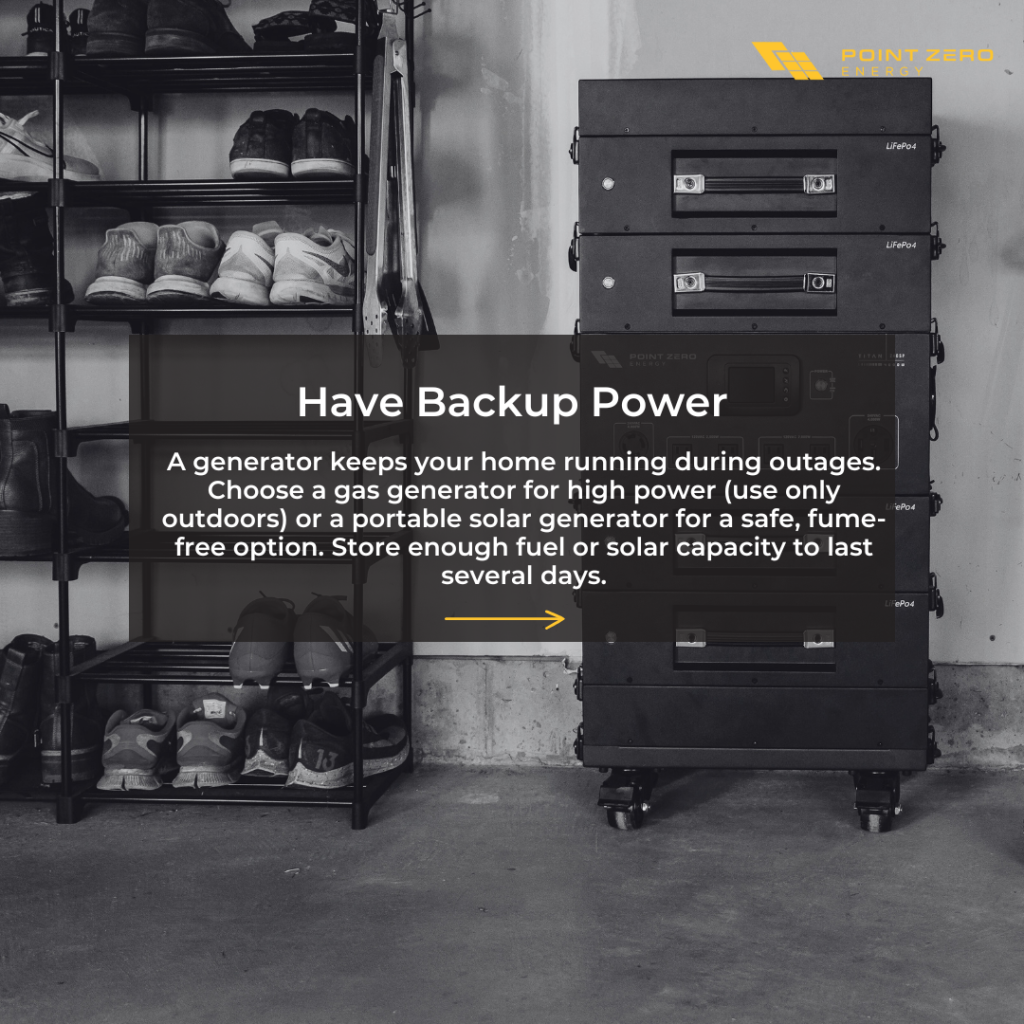
A power outage can disrupt water systems, especially if your home relies on an electric pump. For home preparedness, store at least one gallon of drinking water per person per day for a minimum of three days. Preppers recommend a week’s supply to be extra safe. Additionally, keep extra water for washing and sanitation needs.
If you use well water, power loss can cut off your supply entirely. Have a plan in place, whether it’s storing water in five-gallon refillable jugs or investing in a gravity-fed filtration system.
Additionally, having a backup filtration system, such as a gravity-fed water filter, can provide clean drinking water if your stored supply runs low.
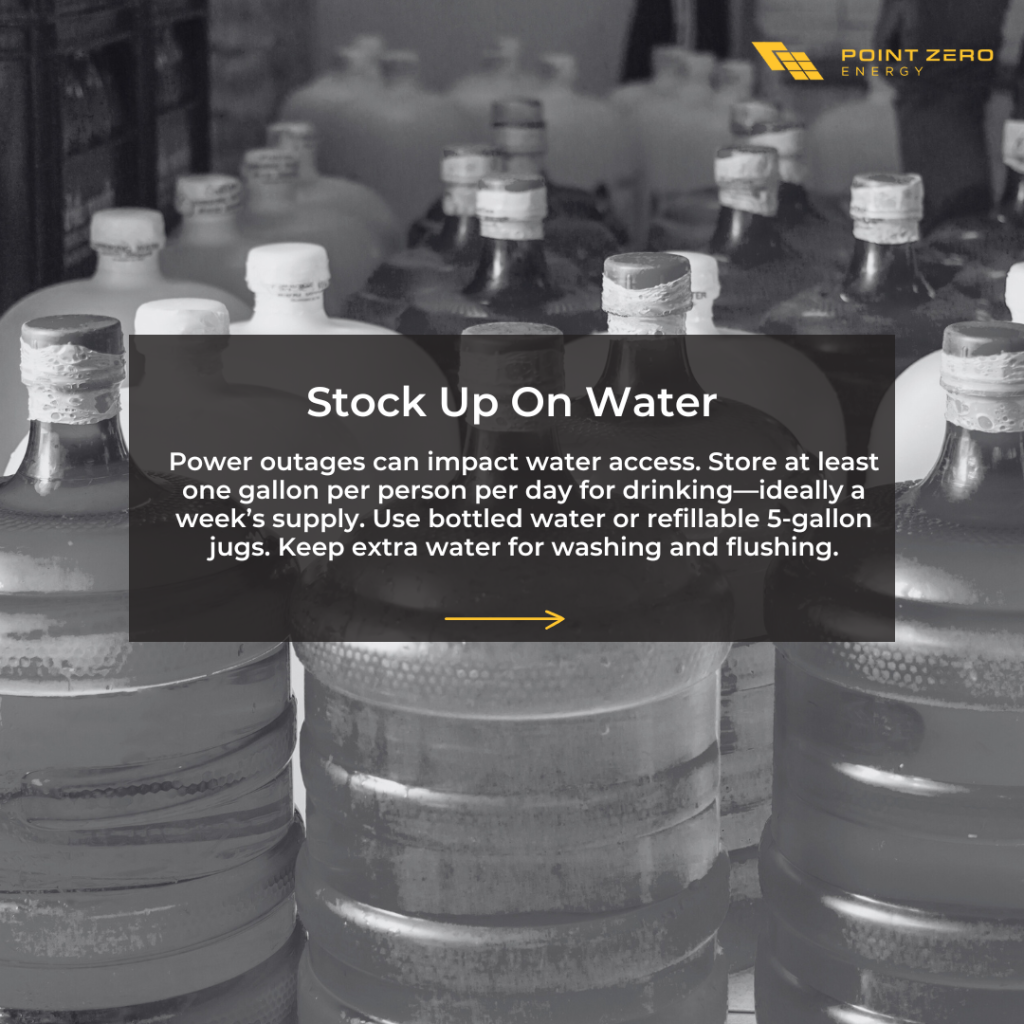
When preparing for emergencies, it’s crucial to ensure you and your loved ones are fully stocked and ready for medical needs. If you or a family member rely on refrigerated medications or medical devices, plan ahead to address these specific requirements. A power outage could disrupt your access to essential equipment, so having a backup power source for critical devices like ventilators, oxygen concentrators, or dialysis machines is vital. In addition to a backup generator or battery-powered alternatives, it’s important to have a cooling solution for temperature-sensitive medications like insulin, which requires refrigeration to remain effective.
Stocking up on vital prescriptions and over-the-counter medications is also a key part of any preparedness plan. We recommend keeping a well-rounded emergency supply that includes the following:
Additionally, it’s recommended to create a medication list with dosages and instructions to ensure that everyone in your household knows what medications are needed and when to take them. You may also want to consider talking to your healthcare provider about obtaining extra prescriptions or over-the-counter medications in advance. Emergency preparedness isn’t just about physical supplies; it’s about ensuring that your family can continue to receive the medical care they need during an emergency. By taking these essential steps, you can safeguard your household’s health, comfort, and safety, even during unexpected disruptions like power outages.
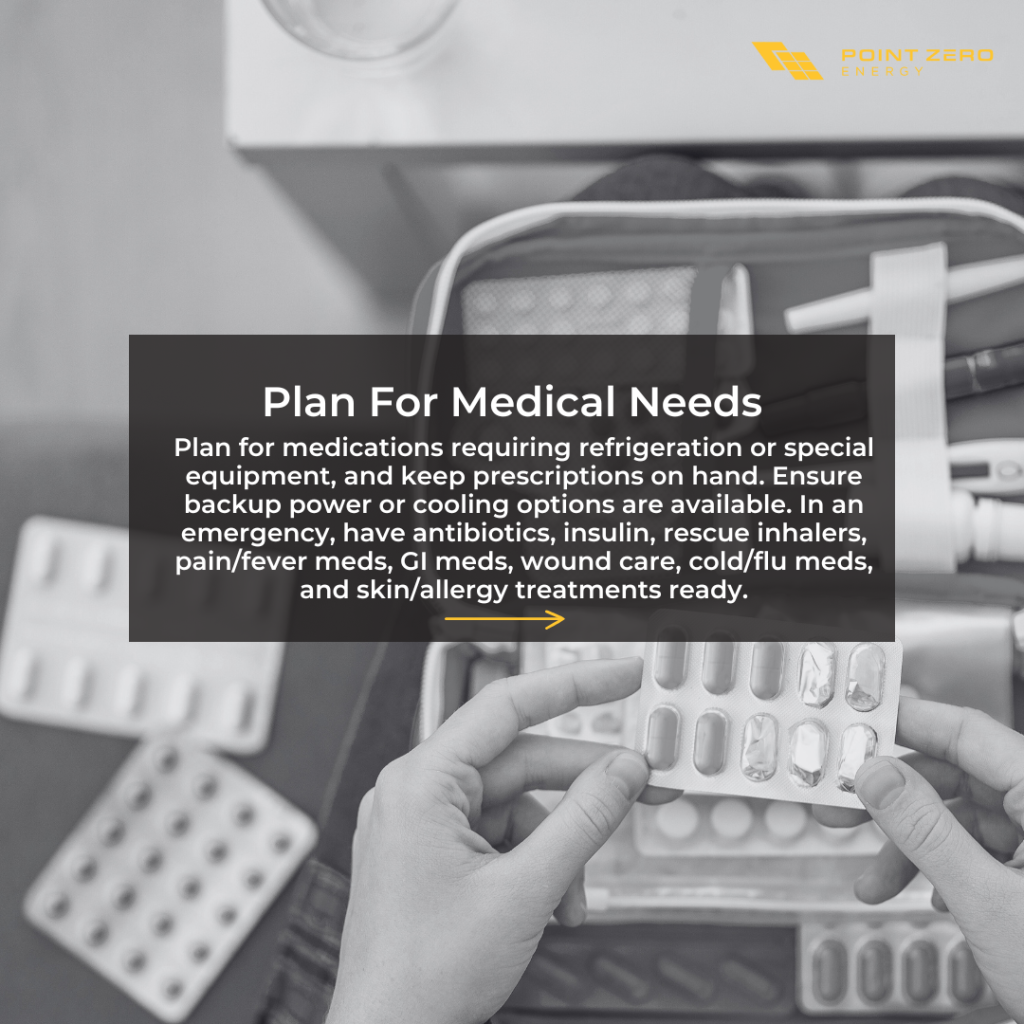
In emergency situations, especially during widespread power outages, gas stations may become inoperable due to their reliance on electricity to pump fuel. This can lead to fuel shortages and make it difficult to refuel your vehicle when you need it most. To avoid being caught without fuel during an emergency, it’s essential to keep your car’s gas tank at least half full at all times. This ensures that you have enough fuel in your vehicle to manage during an unexpected event.
If an evacuation becomes necessary, having a full tank will allow you to drive at least 200–300 miles without needing to stop for fuel. Depending on where you live and the distance between your home and evacuation routes, this could be a critical factor in making it to safety in a timely manner. In some areas, fuel supplies may be limited for days or even weeks, so having a full tank ensures you can make it to a safer location or wait out the emergency without the added concern of running low on gas.
In addition to keeping your vehicle’s gas tank full, preparedness experts also recommend storing extra gasoline in approved, safe fuel containers. If you have the space and ability to do so, storing fuel allows you to top off your tank or use it for other essential equipment, such as generators or power tools, during an emergency. However, it’s important to follow safety guidelines for storing gasoline, as it is highly flammable. Use only approved fuel containers, keep them in a cool, dry, and well-ventilated area away from heat sources, and ensure that they are clearly labeled. Rotating your fuel supply is also important to ensure that it remains fresh and usable over time. Properly stored gasoline can be a lifesaver if you’re ever faced with an extended power outage or natural disaster.
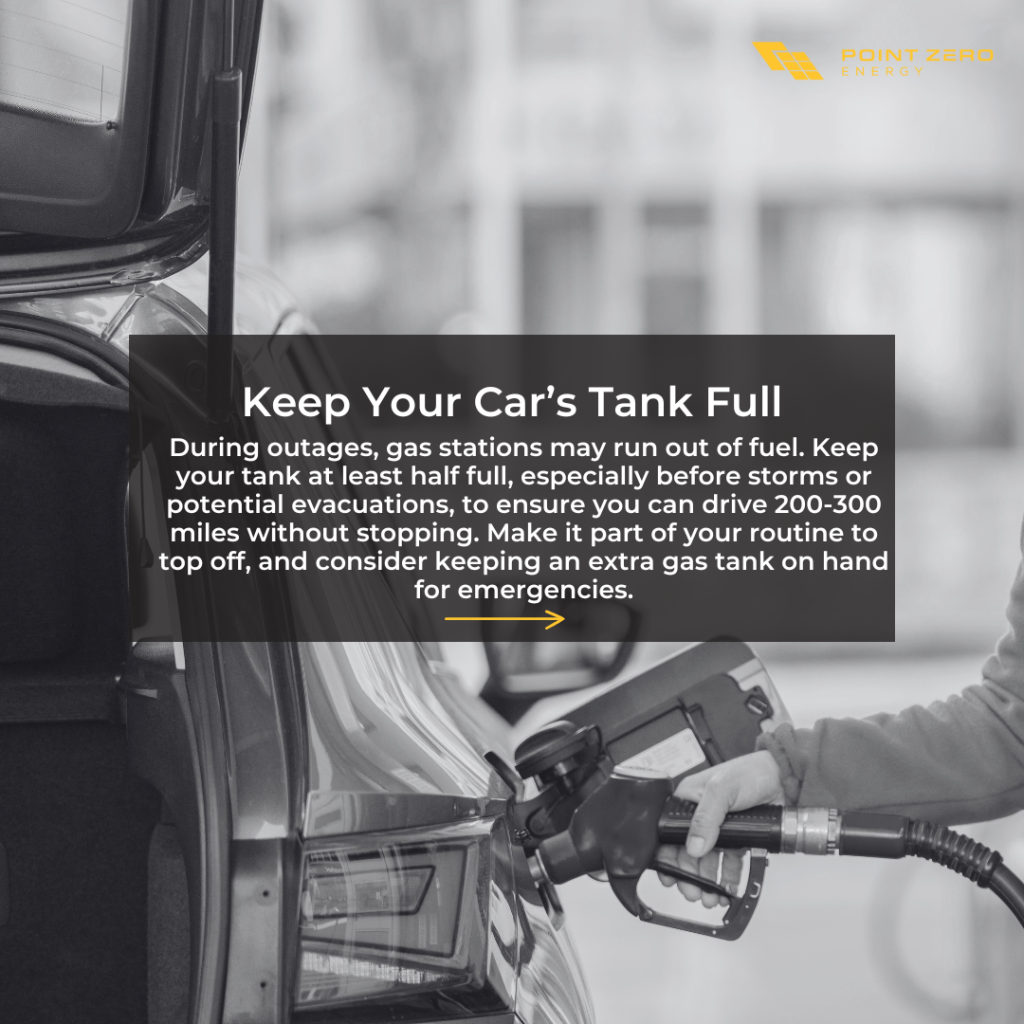
During a power outage, cooking can become a challenge, but if you have a gas stove, you may still be able to cook, depending on whether the stove’s ignition system relies on electricity. If your stove has an electric ignition, you might need to use matches or a lighter to manually light the burners. In the event you don’t have a gas stove or your stove isn’t functional, there are other options to ensure you can prepare meals during an emergency.
Gas-powered grills or camping stoves are excellent alternatives for emergency cooking. These portable options run on propane or other fuels and can provide a steady heat source when needed. However, it’s important to always use them outdoors in a well-ventilated area to avoid the buildup of harmful carbon monoxide, which can be deadly if inhaled. Never use a gas-powered stove or grill inside your home, garage, or enclosed space, even if the windows are open.
Being prepared with a range of food options and cooking tools can make a big difference in maintaining comfort and nutrition during a power outage.
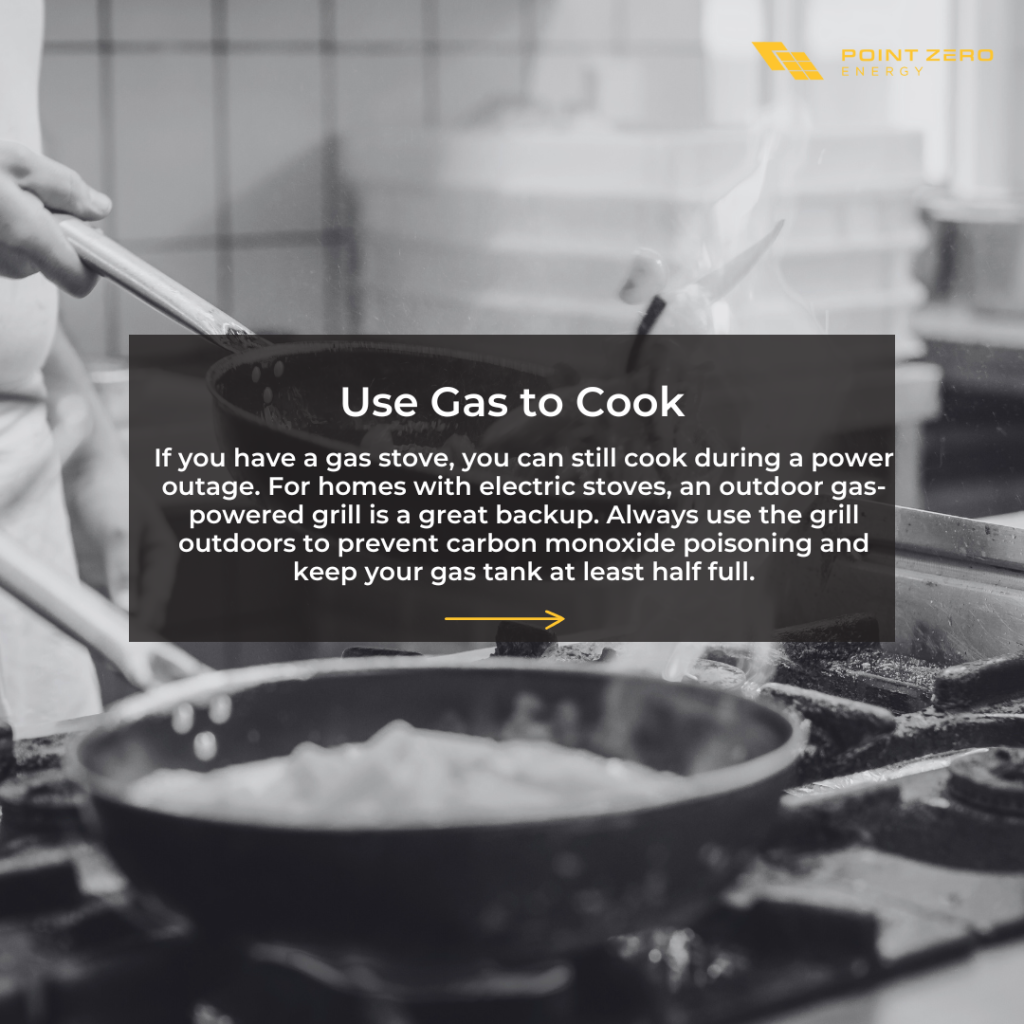
When the power goes out, having reliable lighting sources is essential for safety and comfort. While it’s tempting to rely on your phone’s flashlight, it’s important to have alternative lighting options that don’t drain your phone’s battery. Keeping a supply of battery-powered lanterns, flashlights, and extra batteries in easily accessible locations ensures you’re prepared for an emergency, especially in the dark of night or during long power outages.
Battery-powered lanterns are a great option for providing ambient light throughout the home. They’re often brighter and more effective for lighting up large areas compared to smaller flashlights. Flashlights, on the other hand, are essential for more focused lighting, whether for navigating your home or making sure you can access specific items. It’s also wise to keep headlamps on hand for hands-free lighting, allowing you to move around while keeping your hands free for tasks.
When storing lighting options, consider keeping them in locations where you can easily grab them in an emergency. Think about areas like:
In addition to these lighting tools, you’ll need plenty of extra batteries to ensure they last throughout the outage. Batteries are often used up quickly during prolonged power outages, so keeping a large stash in various sizes (AA, AAA, D, etc.) is critical.
Candles can be used for emergency lighting, but they should only be a last resort, as they can be a fire hazard. Always supervise candles while they’re burning, and ensure they’re placed in safe, stable locations away from flammable materials.
By preparing a variety of lighting solutions and ensuring an ample supply of batteries, you’ll have peace of mind knowing that you can navigate through any power outage safely and efficiently.
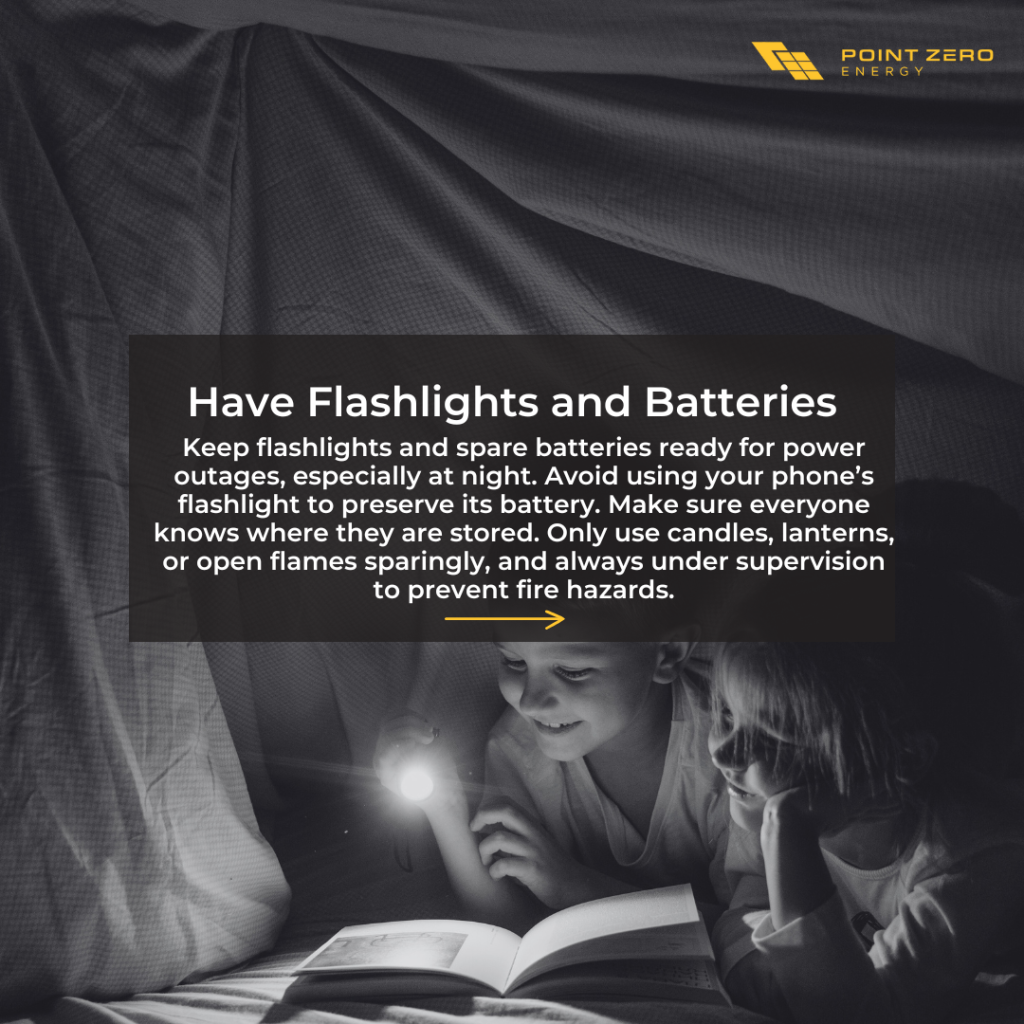
Power outages can often be a precursor to bigger emergencies, making it essential to have a clear and practiced evacuation plan. Knowing when to evacuate is just as important as the plan itself. Set specific conditions for evacuation, such as:
Once you’ve established evacuation criteria, make sure everyone in the entire household knows where to go. Whether it’s a nearby relative’s house, a community shelter, or lcoal park, having a destination ready will save time in the chaos of an emergency.
When preparing for an evacuation, one of the most important steps is ensuring you have a Go-Bag packed and ready to grab at a moment’s notice. A Go-Bag is a portable, pre-packed emergency kit containing essential items you’ll need to survive for at least 72 hours. It can be a lifesaver during an evacuation, especially if power outages or other emergencies disrupt your access to supplies.
Here’s a breakdown of what to pack in your Go-Bag:
Practice Your Plan Regularly
Having a plan is important, but practice is key. Regularly run through your plan with your family so everyone knows their role and the best routes to take. This reduces panic and confusion if an emergency occurs, ensuring you’re all prepared to evacuate quickly and safely. A detailed, practiced plan can make all the difference in an emergency.
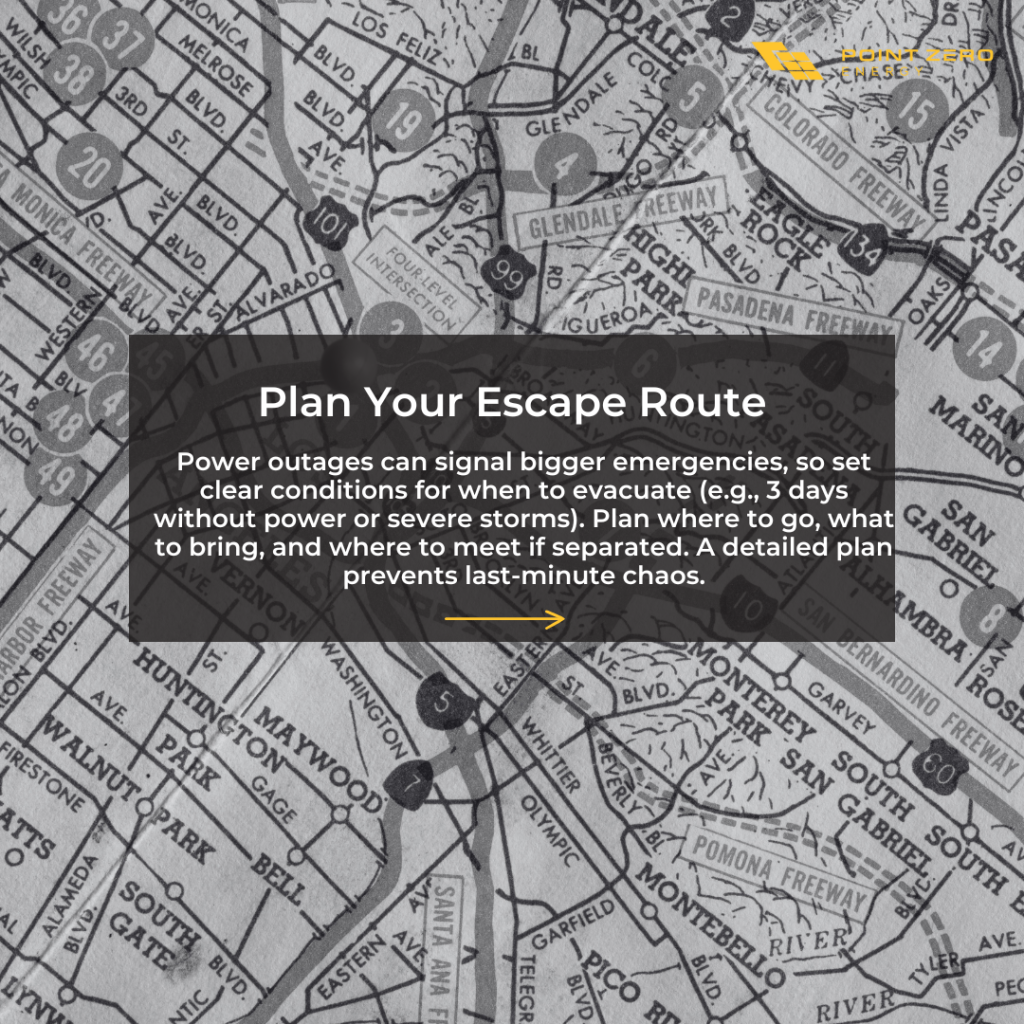
During a power outage, staying informed is critical to ensuring your safety and making the right decisions for your family. While it’s tempting to rely on your phone for updates, you may lose access to WiFi or experience a dead battery during an extended outage. This is where having alternative sources of information becomes essential.
Battery-powered or hand-crank radios are invaluable tools in power outages. These radios can receive emergency updates from local authorities, weather alerts, and crucial information about the status of the power outage. They don’t rely on electricity, making them one of the most reliable ways to stay informed when the grid goes down. Keep one with extra batteries in your emergency kit and ensure it’s easy to access when needed.
In addition to a radio, you should also bookmark official alert sites on your phone or device. These sites
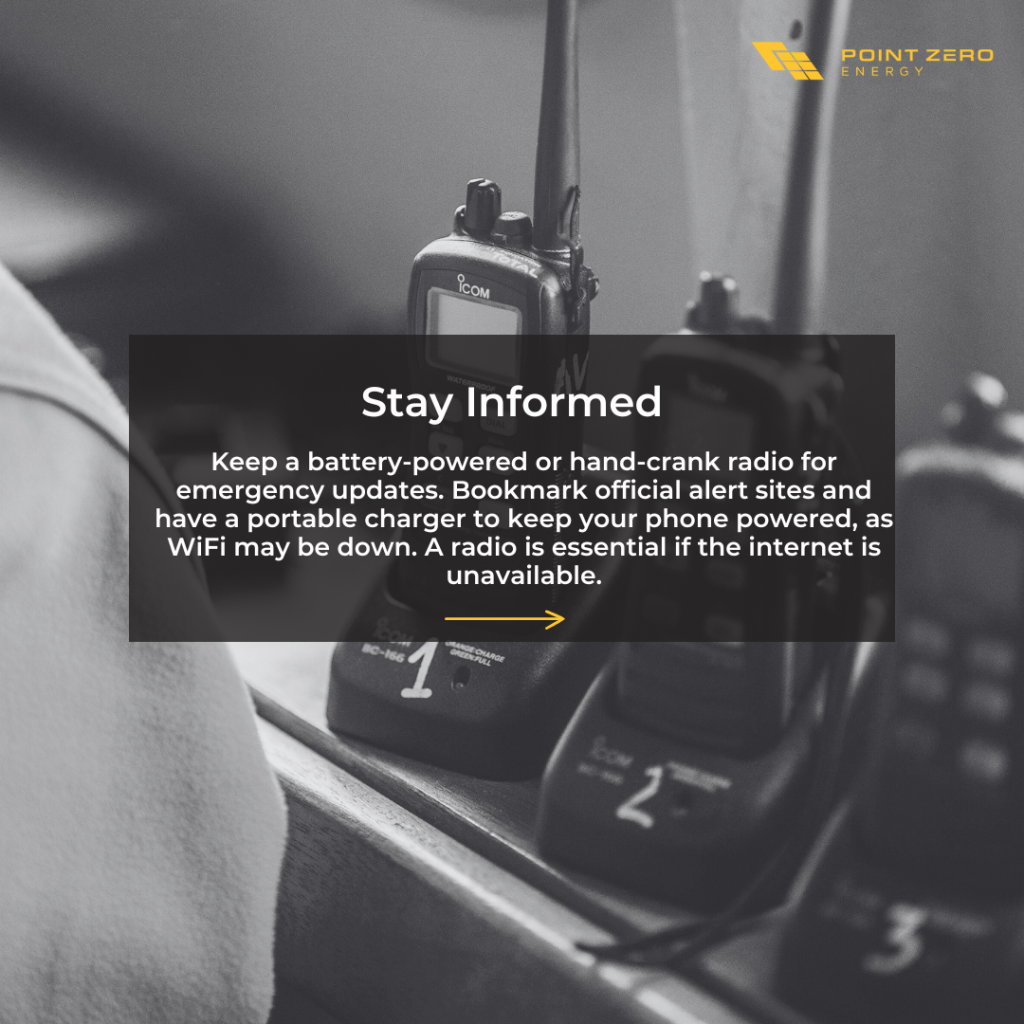
When the power returns after an outage, voltage spikes or surges can cause significant damage to sensitive electronics and appliances. These power fluctuations, which often occur as electricity is restored, can be a hidden danger that many people overlook while focusing on the immediate effects of the outage. To protect your valuable equipment, it’s crucial to take preventive steps before and after the power goes out.
Plug devices like computers, TVs, and home entertainment systems into surge protectors. These devices absorb excess voltage during a power surge, protecting your appliances from damage. Choose surge protectors with a high joule rating for better protection.
Unplug electronics and appliances, such as computers and refrigerators, during an outage. This simple step prevents them from being exposed to voltage spikes when power returns.
For critical devices like medical equipment, security systems, or work-from-home setups, invest in a UPS. A UPS provides temporary power during an outage, ensuring devices stay operational long enough to prevent data loss or failure.
By taking these precautions, you can protect your appliances from damage and ensure they remain safe and functional during a power outage.

Power outages are becoming more frequent and longer-lasting. In 2022 alone, U.S. customers experienced an average outage time of over 7 hours, with severe weather contributing to more than 70% of all disruptions. Power outage preparation is no longer optional—it’s essential for safety and survival.
Take these emergency tips seriously and make a plan today. Stay ahead of the next blackout by prepping your home and sharing this guide with family and friends. Emergency preparedness starts now!

